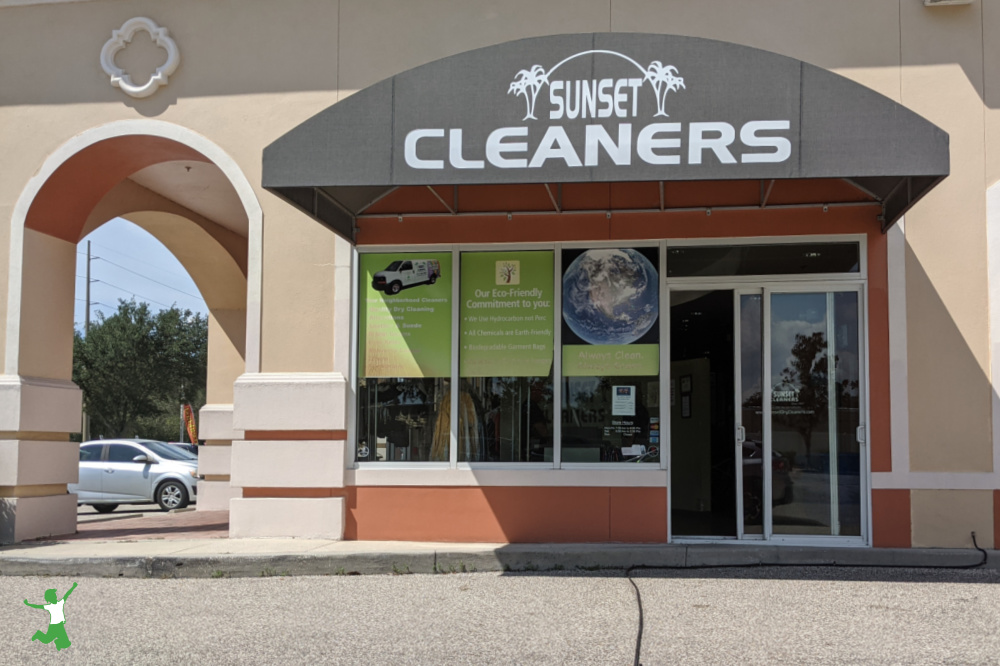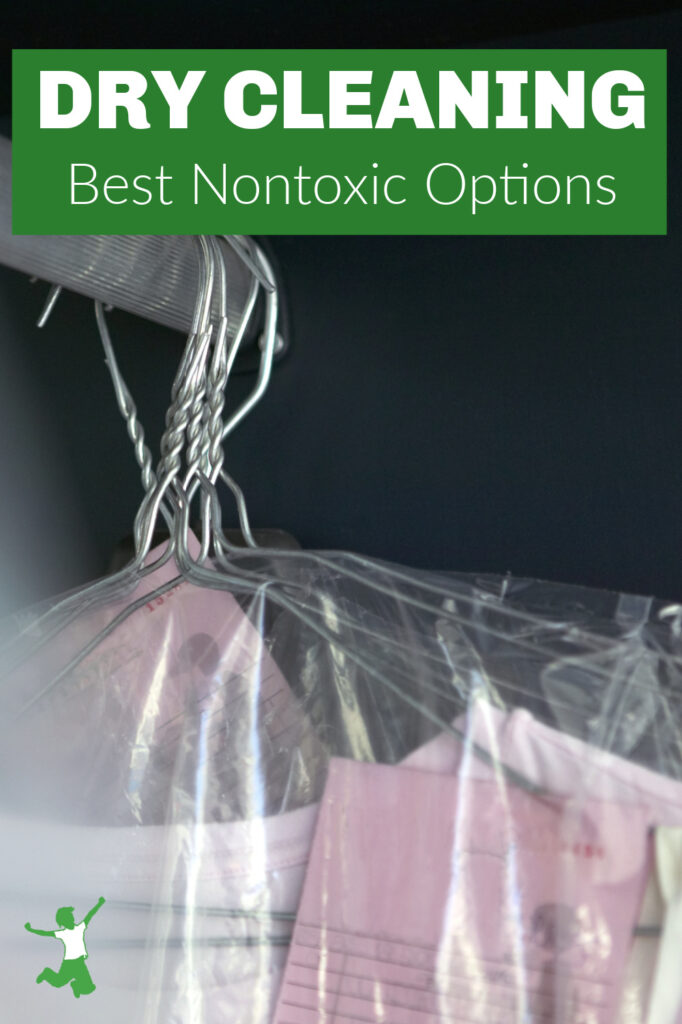Options for safe, green dry cleaning of clothes, bedding, curtains, and other hard-to-clean items that are nontoxic and completely free of solvents and other hormone-disrupting chemicals.

Dry cleaning is big business in developed nations around the world.
According to Proctor and Gamble, the average woman spends about $1500 per year on dry cleaning thanks to the pink tax. (1)
Even more surprising, 65% of clothes that are dry cleaned are actually machine washable!
Most consumers don’t give a second thought to how their clothes are dry cleaned or what chemicals are used. It is also often overlooked that recycling dry cleaning hangers is an easy step consumers can take to reduce waste in the industry.
Dry Cleaning Solvents
The overwhelming majority of dry cleaning businesses use perchloroethylene or tetrachloroethylene (PERC or PCE), a solvent and probable carcinogen.
Dry cleaners love these solvents because they clean delicate fabrics without shrinking or fading.
These chemicals linger on clothes for hours or even days after the customer has taken the dry cleaned clothes home.
The practice of enclosing the finished garments in plastic further encourages the retention of residual PERC/PCE in the clothing fibers.
Vapors are then released into the air of your home when you remove the plastic and put the clothes into your closet.
You can be breathing solvent vapors in your bedroom while you are sleeping and not even realize it because PERC/PCE are odorless once evaporated.
Short-term symptoms from exposure include dizziness, fatigue, headache, and sweating.
Lack of coordination and unconsciousness are also possible.
Long-term exposure can cause kidney and liver damage and is a probable cancer risk. (2, 3)
PERC has a very strong and fresh-smelling scent. Because it is not off-putting, many people don’t give it a second thought.
You’ve probably gotten a whiff of it before while removing the plastic bag from your newly dry cleaned clothes.
Remember that once evaporated, your nose cannot detect it. So, smelling nothing does not mean these solvents are gone!
Reducing Exposure to PERC
Once you realize the danger of dry cleaning solvents, the next step is to reduce or eliminate exposure completely.
Here are a few strategies to consider and implement if they work for your situation.
Dry Clean Fewer Clothes
The first and most obvious way to cut your exposure to toxic dry cleaning solvents is to dry clean fewer clothes.
Given that 65% of the clothes dry cleaned by the average woman could, in fact, be machine washed provides ample room for an immediate and significant reduction in exposure.
Remove Plastic Outside
A second way to cut your exposure is to unwrap your newly dry cleaned clothes outside.
Let them hang in the fresh air or garage for a few hours before bringing them inside and placing them in your closet.
Unwrapping them in the house is NOT a good idea, as vapors will be released and can linger for up to a week!
Call Health Department
If you work or live in a building that houses a dry cleaning business, call the local health department to check on PERC or PCE levels in the air.
Dry cleaning solvents have been known to seep into nearby apartments and offices, contaminating the air.
Get Air Filters
If you live in such a situation, it is a good idea to invest in HEPA air filters (1 unit for every 500 square feet) to ensure your indoor air is safe for breathing.
This is a good idea anyway as there are many more volatile organic compounds (VOCs) besides PERC and PCE that can contaminate indoor air.
What About At-Home Dry Cleaning Sheets?
One option some people are switching to is home dry cleaning.
This method involves purchasing dry cleaner sheets (like these) that can be used on the “no heat” setting of your dryer.
Unfortunately, these sheets are coated with chemicals similar to toxic fabric softener sheets including hormone-disrupting synthetic fragrance.
Home Dry Cleaner Sheets Ingredients DISTILLATES (PETROLEUM), LIGHT HYDROTREATED,HEXYL CINNAMAL,BENZYL SALICYLATE,LILLAL,LINALOOL,FRAGRANCE
Sadly, while this option is better than taking your clothes to a regular dry cleaning business that uses solvents, it is still an unsafe method.
You are simply swapping one type of chemical for another with different health effects!
Support Your Local Green Dry Cleaning Business!
To eliminate exposure completely, it is wise to check to see if there are any green dry cleaning businesses in your area.
Eco-friendly dry cleaners use liquid carbon dioxide (CO2) to clean garments.
Beware of dry cleaning greenwashing, however. Some cleaners promote themselves as eco-friendly by using an “organic” solvent called DF-2000. This solvent is actually made from petroleum and is not truly organic at all. (4)
By comparison, the carbon dioxide method is not harmful to the environment. Remember that plants and trees breathe CO2. It is a main component of clean, healthy air.
In addition, our very bodies are carbon-based. It is not the climate-destroying toxin as vilified by mainstream media.
The best news is that the carbon dioxide dry cleaning process leaves no chemical residues that can harm the customer.
Our family has used green dry cleaning for a couple of decades now.
We have been extremely happy with the results, not to mention the peace of mind knowing that no solvent vapors are floating around our home.
Be aware that green dry cleaning is a bit more expensive than a regular dry cleaner.
In the long run, the few dollars extra spent is worth it considering the alternative.
As suggested by Joel Salatin, best-selling author and the pastured-based farmer featured in The Omnivore’s Dilemma, if you think switching to an eco-friendly dry cleaning business in your community is expensive, “have you priced cancer lately?”

(1) Women Pay More For Dry Cleaning Because They’re Women
(2) Risk Evaluation for Perchloroethylene
(3) Perchloroethylene/tetrachloroethylene (PCE or Perc)
(4) Alternatives to PERC in Professional Garment Cleaning








I never get anything dry cleaned and usually just say f*** it and hand wash or gentle cycle at the least. But… I have this wool peacoat that I love and I would be very angry at myself if I ruined it. How do I find a good Eco cleaner? Are there questions I should ask to make sure they are truly leaving those harmful chemicals out?? I typed a search into yelp and a bunch of places came up but how do I make sure they are truly green and safe?
If you have a good (and, living in Europe, I would say German = less water, less liquid, great results. I adore my Miele) washing machine you can wash almost everything on the wool program with the spin on minimum (400) or the silk program; this is sometimes better than handwashing which can be rough (no wringing, wrap in a towel only!). Make it cold if the colours are strong and might run. Dry flat if it might stretch out of shape. Use a gentle natural soap on stains beforehand and rinse out before washing (many fragile washes are so gentle they will not get rid of an excess of soap). I do all my fragiles like that and I have a lot of silks/jerseys. Even unlined silk jackets can easily be washed at home. We still send my husband’s suits to the dry-cleaners but he doesn’t need to wear one everyday anymore and for me the odd jacket but it can’t be anywhere near 200$/year. If it doesn’t survive the washing machine I resign myself to the fact it wasn’t made for me…
Thank you, Ashley, for taking the time to inform us about this eco dry cleaning process.
I wanted to contact you about the Solvair Cleaning System (Solvair), which may be of interest to you and your readers.
Solvair is a new option for consumers that represents a major scientific breakthrough in dry cleaning; an eco-friendly clothing care technology that truly works. As a system, it has been purposely designed to ensure that both superior cleaning results and good environmental practices are built into the system.
Solvair cleans clothes with a biodegradable cleaning fluid, conceptually similar to water and detergent in your home washer. Instead of drying clothes with heated air, like traditional dry cleaning or a home dryer, Solvair uses a unique cold liquid carbon dioxide (CO2) drying process.
Every aspect of the technology was engineered with environmental, worker and consumer safety in mind. For more information please visit http://www.solvaircleaning.com.
Thank you,
Ashley Bower
Marketing & Communications Manager
Solvair LLC
The $1500 figure shocked me too.
Regarding what you can machine wash, read the tag .. if it says "dry clean only", then you should take to a green dry cleaner to avoid PERC exposure. Some of my clothes day "machine wash or dry clean", so for those, I wash them on delicate cycle.
Any tips on determining which dry-clean clothes can be machine washed? I've ruined clothes doing that before.
Really? $1500 – that's absoultely incredible!!! I have never taken a thing to the dry cleaners. Maybe I'm just dirty – but no PERCs for me!!
This is an easy-peasy one for me! I have nothing that needs to be dry-cleaned! I get most of my clothing at Goodwill or thrift stores and I make sure that everything is hand or machine wash only. Dry cleaning can be so expensive…and when I only pay $3 for a sweater, why would I want to spend $5 or more to get it dry cleaned?
I love Salatin's quote and have it on my blog's sidebar.
Sarah…I get SO much out of your posts and your little video clips! Your blog has become one of my favorites!
Cindy
Hi Paula, the dry cleaning chain "Martinizing" has a green dry cleaning process. I think this chain is actually nationwide in the USA.
Excellent closing line!! Your timing is uncanny. Just yesterday I was debating on whether to dry clean or wash a new shirt of my husbands. It was silk and the label said either or but cry cleaning was best. Deciding I preferred to take the chances with how it would turn out rather than have chemicals on my skin I washed it. After all, silkworms get wet. I live in your area, where is a "green" dry cleaning service?